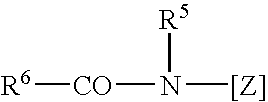Textile Care Agent Having Cellulose Ether Comprising Amine Groups
- Summary
- Abstract
- Description
- Claims
- Application Information
AI Technical Summary
Problems solved by technology
Method used
Image
Examples
example 1
Softness
[0164]Table 1 shows liquid formulation M1 according to the invention and the comparison formulation V1. All values are stated in weight percent, in each case relative to the entire agent.
TABLE 1M1V1C12-14 sodium alkyl ether sulfate55C12-C18 fatty alcohol + 7 EO11 11 C14-16 alkyl glucoside22Trisodium citrate11Glycerol55Amine-modified cellulose ether1—Waterto 100to 100
[0165]Disposable terry towels (100% cotton) were washed 1× and 3× with the washing agent under the following conditions
Washing machine:Miele W 918Primary washing:One-wash coloreds cycleWashing40° C.temperature:Liquor volume:17 lWater hardness:16 German hardness degreesFiller load:3.5 kg of clean laundry incl. test fabric (pillow case,jersey fabric, dishtowels, huckaback weave towels)
and air dried after each washing. After the 1st and 3rd washing cycle, the softness of the test fabric was determined sensorially in comparison with standards by a group of experienced subjects. The result is significantly positive, i...
example 2
Elasticity
[0168]The test textiles stated in Table 2 below were in each case washed with 120 g of the agents stated in Example 1 [water hardness: 16 German hardness degrees] (Miele W308; one-wash cycle 40° C. normal program) and then dried (2 days hanging from a line in a conditioning room at 20° C. and 65% atmospheric humidity).
[0169]The washing and drying cycles were in each case repeated 9 times (i.e. 10 washing / drying cycles in total).
[0170]The textile to be tested was stretched for 1 minute by 80% of the original length in a dynamometer (Hounsfield H5KS), then released for 3 minutes, after which the remaining residual elongation was measured. Table 2 below shows the residual elongation of the unwashed textile (U) and the residual elongation determined after use of agents M1 and V1 respectively.
TABLE 2Residual elongation [%]TextileUV1M1Pullover (100% cotton)285539Pullover (76% dressed cotton / 19%8148PA / 5% elastane)
[0171]It can be seen that using the agent according to the inventio...
PUM
| Property | Measurement | Unit |
|---|---|---|
| Solubility (mass) | aaaaa | aaaaa |
| Molecular weight | aaaaa | aaaaa |
| Shape | aaaaa | aaaaa |
Abstract
Description
Claims
Application Information
 Login to view more
Login to view more - R&D Engineer
- R&D Manager
- IP Professional
- Industry Leading Data Capabilities
- Powerful AI technology
- Patent DNA Extraction
Browse by: Latest US Patents, China's latest patents, Technical Efficacy Thesaurus, Application Domain, Technology Topic.
© 2024 PatSnap. All rights reserved.Legal|Privacy policy|Modern Slavery Act Transparency Statement|Sitemap



